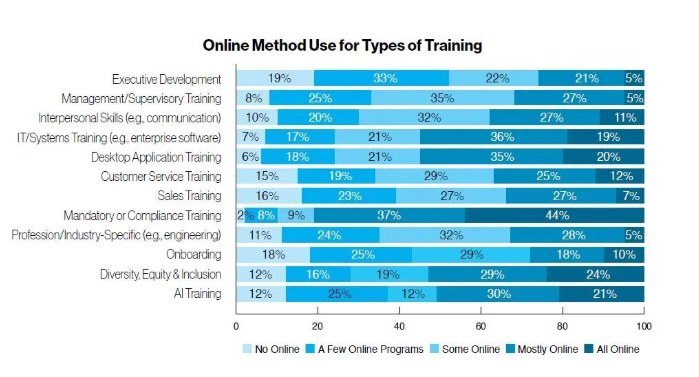According to the 2025 Training Industry Report, 34 percent of all training hours delivered by U.S.-based organizations with 100 or more employees came from online or computer-based technologies. With online learning maintaining a major share of overall delivery, it remains an essential format for many organizations. This blog explores how long it takes to create e-learning, and why demand for digital training continues to hold steady.
Online education vs. traditional education
Online education offers self-paced learning and access to a wide variety of courses at lower cost. It is especially efficient for knowledge-based or theoretical content and can be scaled quickly across large organizations. However, online formats still lack the in-person interaction that supports networking, relationship-building, and deeper engagement. They also tend to be less effective for hands-on or performance-based training.
Traditional education, delivered in a face-to-face setting, offers structured learning with stronger personal interaction. It’s ideal for experiential training, collaborative activities, and leadership or interpersonal skill development. The trade-offs are higher costs, less flexibility, and fixed scheduling that may not meet the needs of distributed or hybrid workforces.
How organizations used online training in 2025
The 2025 Training Industry Report confirms that online education remains the most commonly used delivery format for several training categories.
- Mandatory or compliance training: 92% of organizations deliver at least some of it online, and 45% offer it fully online (slightly down from 48% last year).
- High-use online categories: IT/systems training — 76%, Desktop application training — 75% DEI training — 72%, Interpersonal skills training — 70%, Management/supervisory training — 67%, Customer service training — 66%, Profession- or industry-specific training — 64%, AI training — 63%, Sales training — 61%, Onboarding — 56%.

Source. Trainingmag.com
Time to create elearning
With so much reliance on online training like eLearning, we thought we would explore the time it takes experienced training creators to create an online course.
Several factors, including the complexity of the content, types and number of simulations, or branching scenarios, influence the time and cost to build eLearning. Longer courses demand more resources to design, while courses with higher interactivity (e.g., gamified elements or custom animations) are more resource-intensive.
Finally, training team expertise, number of review cycles during course production, compliance with accessibility standards and localization for multilingual audiences can further increase development requirements.
Here are five sources that provide insights into how long it takes to create eLearning:
ATD
In 2020, the Association of Talent Development surveyed over 250 respondents, and this is how long they said it took them to develop e-learning:
| e-Learning Type | Avg. Length | Min. Time to Develop | Max. Time to Develop | Avg. Time to Develop |
| Passive (page turners) | 20 min | 38 hrs | 79 hrs | 48 hrs |
| Partial engagement (drag and drops, rollovers, simple animations, gamified elements) | 26 min | 65 hrs | 115 hrs | 84 hrs |
| Moderate engagement (some games, activities, or simulations) | 20 min | 74 hrs | 194 hrs | 116 hrs |
| Full engagement (many immersive games, scenarios, or simulations) | 17 min | 70 hrs | 694 hrs | 155 hrs |
eLearningArt
eLearningArt provides a neat calculator to estimate how long it will take to build eLearning based on the input, course length and complexity of the eLearning course. Here are their estimates for a 30-minute eLearning course:
Input | Course length | Development time for average eLearning output | ||
Level 1: Text and graphics only, “click and read” | Level 2: Text, graphics, with simple branching, quizzing, and user participation | Level 3: Highly interactive, with branching scenarios and non-linear navigation | ||
Instructor-led training | 30 min | 43.5 hrs | 98.5 hrs | 233 hrs |
Voice over script | 30 min | 43.5 hrs | 98.5 hrs | 233 hrs |
Slide deck | 30 min | 43.5 hrs | 98.5 hrs | 358 hrs |
Christy Tucker Learning
The estimate from this source is older and likely does not include some of the innovations available to today’s content creators and instructional designers. However, it shows the tasks involved in creating eLearning and how long it takes to do each using traditional methods.
Christy estimates it will take her approximately 450 hours to create 3 hours of interactive eLearning. This is the time it takes for each task:
Task | Time Estimate |
Front-end analysis | 30 hours |
Instructional design | 60 hours |
Storyboarding | 55 hours |
Graphics | 66 hours |
Authoring/Programming | 180 hours |
QA Testing | 33 hours |
Project management | 20 hours |
Pilot testing | 6 hours |
This list is a great way to compare the time and effort you save when using new tools and technologies.
Racoon Gang
Racoon Gang says that it can take 40 to 160 hours to develop one hour of e-learning content, depending on complexity, multimedia integration, and team proficiency. This includes planning, content creation, multimedia production, and quality testing to ensure optimal learning outcomes.
e-Learning.net
eLearning.net estimates it takes between 70 and 320 hours (2 to 6 weeks) and between $5,995 to $14,995 to create eLearning. Here is how they breakdown the time:
Task | Task Description |
Instructional Design | High (20-30 hours): You are starting from the ground up and must perform all instructional design tasks, including defining your organizational objectives. Moderate (10-20 hours): You have some foundation, such as prior training experience on this subject or significant instructional design work already completed. Low (0-10 hours): You have a fully developed content outline aligned with your learning objectives, along with test/quiz questions, answers, activity design ideas, and other instructional elements |
Content Writing | High (30-60+ hours): If you have minimal or no source content, expect to spend 1-2 hours per minute of content on tasks such as researching, interviewing subject matter experts, writing, editing, gathering feedback and approvals, and finalizing the draft. Moderate (15-30 hours): If most of your content is already written and nearly ready for integration into an eLearning storyboard, plan to invest 30 minutes to 1 hour per minute of content to create a production-ready script and visual storyboard. Low (0-15 hours): If you already have a completed eLearning narration script and a detailed storyboard with accurate graphic design requests, on-screen text, and specific development instructions, you may only need a few working days to refine and finalize the content. |
Visual Design | High (40-60 hours): This is ideal if you aim to create a course with a polished, professional, and visually stunning design aesthetic. Moderate (15-40 hours): This is suitable for a “semi-custom” course design, which includes some custom imagery (e.g., charts/graphics) complemented by royalty-free stock photos tailored by a Graphic Designer to align with your branding and style guide. Low (5-10 hours): This is perfectly acceptable if you’re comfortable with a course that resembles a “glorified PowerPoint,” relying on royalty-free stock images with minimal or no professional graphic design involvement. |
Activity Complexity | High (30-70 hours): Includes complex interactivities such as multi-step branching scenarios, hot spots, drag-and-drop features, custom point tracking systems, and other advanced interactive elements requiring custom programming. Moderate (15-35 hours): Features custom-designed activities like drag-and-drop, labelling, categorizing, and other interactive elements that align with your branding and incorporate custom graphic design and programming techniques. Low (0-8 hours): Utilizes pre-built activity types, such as native activities in Storyline, or third-party eLearning activity templates, with minimal customization required. |
Multimedia | High (40-70+ hours): Involves commercial-grade video production using advanced tools like Adobe After Effects, Premiere, and others. This may also include creating custom 3D objects and animations using software like Maya, 3D Studio Max, or VRAY. Moderate (10-40 hours): Focuses on consumer-grade video production, utilizing tools like Camtasia and Captivate for screen capture, with additional editing in tools like Adobe Premiere or similar software. Low (0-10 hours): Includes basic screen captures with minimal or no post-production/editing or no video at all. Most animations involve simple synchronization of text and images to audio using built-in features of tools like Articulate Storyline or Captivate. |
QC Review | High (30+ hours): Plan for approximately 1 hour per minute of content if you intend to assign a dedicated internal quality control (QC) expert to review and test all aspects of the courseware thoroughly. This exhaustive process aims to catch most or all errors and involves multiple iterative reviews of the storyboard and media production. Moderate (15-30 hours): Suitable for a streamlined QC process that ensures all course elements function correctly and without significant grammatical or technical errors. Low (5-15 hours): Best for less complex courses where strict adherence to detailed design standards is not required. For example, minor formatting preferences (e.g., bullet points or numbered lists) can be overlooked, reducing QC time. |
How LEAi reduces the time to create eLearning
LEAi by LearnExperts is an AI-enabled tool designed to reduce the time it takes to create eLearning content through the following features:
- Automated e-learning content creation: LEAi uses AI to automatically generate training modules from existing content, such as documentation, presentations, or knowledge bases. This significantly reduces the time spent creating content from scratch.
- Streamlined workflow: LEAi efficiently organizes and structures information from multiple documents to identify key topics and arrange them into a logical flow, saving time on planning and course development.
- Added interaction: LEAi suggests test questions and demonstrations in minutes, reducing the time needed to create content and assess whether the learner understands the presented concepts.
- Rapid updates: When content needs to be updated (e.g., due to product changes or new policies), LEAi can quickly adjust the existing materials, minimizing downtime.
- Collaborative tools: LEAi enables teams to collaborate in real-time, streamlining development time by reducing the time spent on reviews and approvals.
- Focused expertise: By leveraging AI, LEAi ensures content is precise and tailored to learners’ needs, reducing time spent revising or reworking content to meet objectives.
These features allow organizations to deliver e-learning faster, deliver more training faster, and meet tight deadlines. If you want to accelerate your e-learning production, contact us for a personalized demo.




